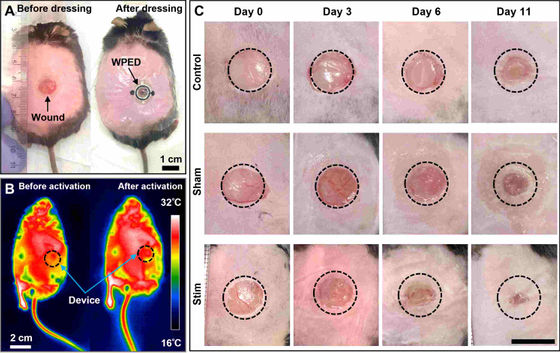DARPA project's 'electric bandage' that accelerates wound healing by 30%

By Rajaram Kaveti
A research team funded by the Defense Advanced Research Projects Agency (DARPA) has developed a wound dressing that uses small electrodes to generate an electric field to heal wounds up to 30% faster. This 'electric bandage' is expected to be highly effective for
Water-powered, electronics-free dressings that electrically stimulate wounds for rapid wound closure | Science Advances
https://www.science.org/doi/10.1126/sciadv.ado7538
Electric Bandage Holds Promise for Treating Chronic Wounds | NC State News
https://news.ncsu.edu/2024/08/electric-bandages/
Chronic wounds are wounds that do not heal for months, and even if they do heal, they often recur, posing serious health problems that can lead to amputations or even death.
Existing treatments for chronic wounds, such as those using skin substitutes, are extremely expensive, costing more than $1,000 per wound, and in some cases up to $20,000, despite only having a 50% chance of healing completely.
Previous research has shown that applying electrical stimulation to a wound can promote cell proliferation and migration, which is effective in wound healing. However, this requires large-scale equipment and several hours of treatment every day, so there is no prospect of it being put to practical use.
So a research team led by Rajaram Kaveti of North Carolina State University developed 'water-powered, electronics-free dressings (WPEDs),' disposable bandages equipped with small electrodes and batteries.

According to the research team, WPED is a spin-off from a DARPA project aimed at accelerating wound healing with personalized wound dressings.
'This collaborative project has shown that our lightweight bandage, which can be delivered by simply adding water, heals wounds faster than controls and as quickly as more expensive, more involved treatments,' said co-author Sam Xia of Columbia University.
The WPED is placed over the affected area, with electrodes making contact with the wound, and then a drop of water is placed on a tiny biocompatible battery on the other side, which creates an electric field over several hours to help heal the wound.

When the research team treated mice with WPED after injury, they found that the wound healed about 30% faster than with a commercially available bandage (Tegaderm).

Despite being equipped with electrodes and a battery, the WPED is only 20% heavier than a commercially available bandage and is flexible enough to be applied properly to areas such as the toes. In addition, it is inexpensive, costing just a few dollars (a few hundred yen) per piece, and patients can continue to live their normal lives while wearing it, minimizing the physical and financial burden on them.
The team is also developing a WPED with three-dimensionally deformable electrodes inspired by Japanese paper-cutting to treat deep wounds with complex surfaces.

'The flexibility of the electrodes is crucial because to deliver the electric field effectively, the electrodes need to be in contact with both the periphery and the center of the patient's wound,' said Cavetti. 'And because these wounds are often deep and asymmetrical, we need electrodes that can adapt to a variety of wound surfaces.'
The research team is currently conducting further tests to conduct clinical trials to commercialize WPED.
Related Posts:
in Science, Posted by log1l_ks







